On this page
Books about Coursers and PratincolesThis page lists books that are wholly or partly about Coursers and Pratincoles. The books are listed by publication date with the most recent at the top.
Coursers & Pratincoles
Family: Glareolidae
The Glareolidae family includes coursers, pratincoles and the Egyptian Plover. Members of the family are found in Europe, Asia, Africa and Australia. There are 17 species:
Australian Pratincole
Stiltia isabella
Black-winged Pratincole
Glareola nordmanni
Collared Pratincole
Glareola pratincola
Grey Pratincole
Glareola cinerea
Madagascar Pratincole
Glareola ocularis
Oriental Pratincole
Glareola maldivarum
Rock Pratincole
Glareola nuchalis
Small Pratincole
Glareola lactea
Burchell's Courser
Cursorius rufus
Cream-coloured Courser
Cursorius cursor
Heuglin's Courser
Rhinoptilus cinctus
Indian Courser
Cursorius coromandelius
Jerdon's Courser
Rhinoptilus bitorquatus
Temminck's Courser
Cursorius temminckii
Two-banded Courser
Rhinoptilus africanus
Violet-tipped Courser (Bronze-winged courser)
Rhinoptilus chalcopterus
Egyptian Plover
Pluvianus aegyptius
|
|
|
|
Nocturnal Birds of Southern Africa
John Carlyon
Photographs: John Carlyon and Penny Meakin
2012
"Nocturnal Birds of Southern Africa brings the largely unseen world of night birds to the reader in the pages of this authoritative photographic guide, the first to cover the full spectrum of these attractive but elusive creatures in the region in detail. The 300-plus pages of this attractive and colourful hardcover book are richly illustrated with nearly 400 high-quality photographs and illustrations, most of which have not previously been published. Photography is by John Carlyon and Penny Meakin, with additional photography by several leading bird photographers. This expansive portfolio of images covers all important aspects of typical adults, nests, eggs or nestlings, juveniles and habitats for each species discussed. Text is informative and clearly written, unencumbered with technical jargon or data. Introductory chapters discuss this group of birds in general terms in the southern African context. The species accounts, covering owls, nightjars, the Bat Hawk, night herons, thick-knees and coursers as well as partially nocturnal birds in the southern African subregion, summarise current knowledge of these birds in an easily readable style."
|
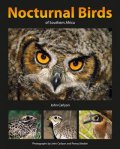 |
|
Shorebirds of the Northern HemisphereRichard Chandler
Helm Identification Guides
Christopher Helm
2009
"Shorebirds are a very popular group of birds among birders of all standards, though their identification is often a challenge. Covering all the species of the northern hemisphere, this new photographic guide provides all the information a birder will need at a glance. Lavishly illustrated with colour photography by the author, Shorebirds of the Northern Hemisphere focuses on specific and subspecific separation and on ageing to provide a complete identification resource."
|
Buy from amazon.co.uk 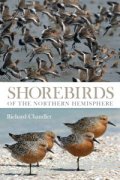
|
|
International Single Species Action Plan for the Conservation of the Black-winged Pratincole Glareola nordmanni
Technical Series No. 4
AEWA
2004
Prepared with financial support from the Ministry of Agriculture, Nature Management and Fisheries, The Netherlands
From the summary: "The Black-winged Pratincole breeds mainly in the steppe and desert belt of Eurasia from Romania and Ukraine in the west to the Russian part of the Altai and to Kazakhstan in the east. It winters in Africa south of the Sahara desert. Migration through the Middle East countries such as Turkey, Iran, Iraq, etc. is probably transit/flyover, and takes place at high altitudes; as a result the Black-winged Pratincole is seldom recorded in this region. Population decline of the Black-winged Pratincole started in the end of 19th century, and became more evident in the second half of the 20th century. In recent years, starting from the 1980s-1990s, a marked population decline again took place: in 10 years numbers decreased by half or two thirds. Currently the total population of the Black-winged Pratincole is unlikely to exceed 10,000-15,000 pairs."
|
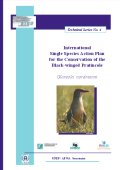 |
|
Nomadic Desert BirdsW.R.J. Dean
Adaptations of Desert Organisms Series
Springer
2003
"There are two basic strategies for coping with life in the desert. The first involves withstanding the extreme conditions using behavioural or physiological tactics. The second strategy is to be a migrant and to opportunistically or seasonally move to where the necessary resources are. Nomadism, i.e. the opportunistic and irregular movements from resource-poor to resource-rich patches, is a tactic that birds, with their mobility, can use, and it is explored by W.R.J. Dean in this volume."
|
Buy from amazon.co.uk 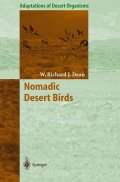
|
|
Handbook of the Birds of the World, Vol. 3: Hoatzin to AuksEdited by Josep Del Hoyo, Andrew Elliott and Jordi Sargatal
Illustrations: Norman Arlott, Hilary Burn, Francesc Jutglar, Ŕngels Jutglar, Ian Lewington, Lluís Sanz, Etel Vilaró, Ian Willis
Lynx Edicions
1996
821 pages, 60 colour plates, colour photos, distribution maps.
This volume covers 30 families including cranes, bustards, rails, gulls, terns, waders and auks.
|
Buy from amazon.co.uk 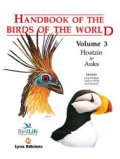
|
|
Handbook of Australian, New Zealand, and Antarctic Birds: Volume 3: Snipe to PigeonsEditor: P. J. Higgins
Illustrations: Jeff Davies
Oxford University Press
1996
"HANZAB is one of the world's major ornithological projects, and the first two volumes have attracted both critical praise and an international market. Volume 3 covers 129 species - the pratincoles, migratory waders and shore-birds, skuas, gulls and terns, and pigeons and doves. Many of the birds are virtually cosmopolitan in their distribution and are familiar to ornithologists throughout the world; such as the migratory waders which travel thousands of kilometres each year from their breeding grounds in the northern hemisphere to spend the southern winter in Australia and New Zealand. Information is presented in sections covering field identification, habitat, distribution and population, movements, food, social organization, social behaviour, voice, breeding, and plumages. Each account has a full list of references and black-and-white illustrations of behavioural postures and plumage features, maps showing breeding and non-breeding distribution, sonograms of calls and songs, and diagrams of timing of breeding and moulting."
|
Buy from amazon.co.uk 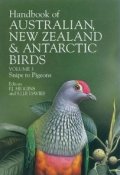
|
|
Ecophysiology of Desert BirdsGordon Lindsay Maclean
Adaptations of Desert Organisms Series
Springer
1995
"The scientific study of birds in arid regions has been conducted more or less intensively for about 40 years. This is an appropriate time to draw together the threads of the diverse research on birds living in such an extreme environment. Topics include: Desert Avifaunas; Food and Energy; Drinking; Water Regulation; Thermoregulation; Timing of Breeding; and Ecology of Breeding."
|
Buy from amazon.co.uk 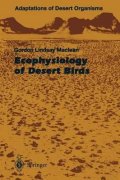
|
|
Breeding Biology Of The Egyptian Plover, Pluvianus aegyptiusThomas R Howell
Publications In Zoology, Volume 113
University of California Press
1979
|
Buy from amazon.co.uk 
|
|